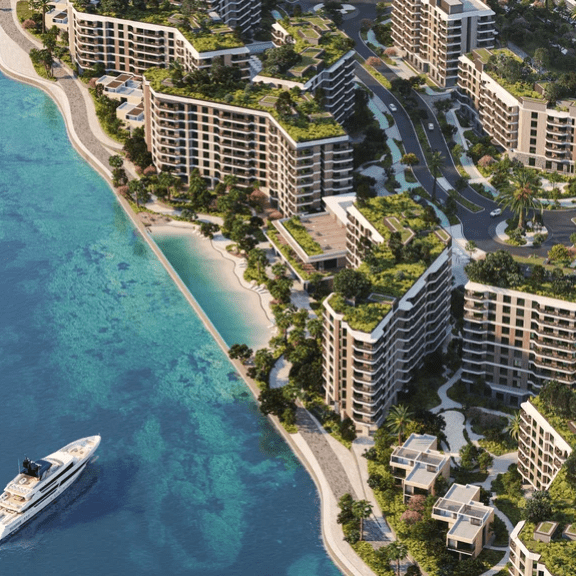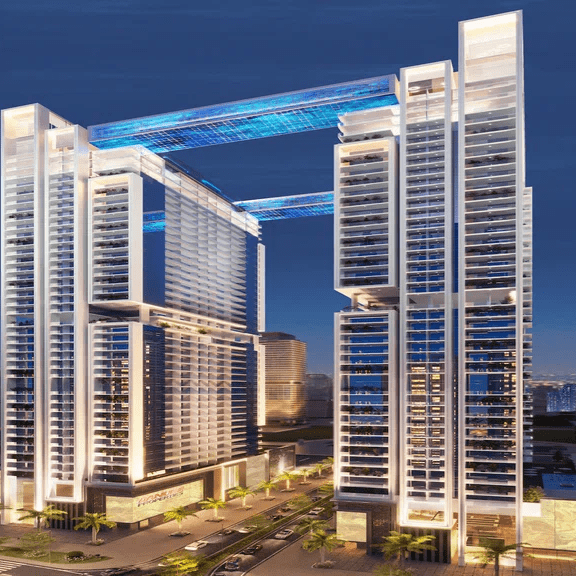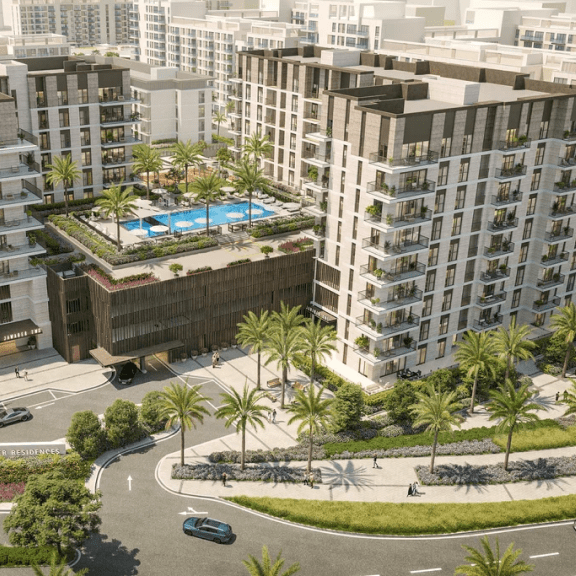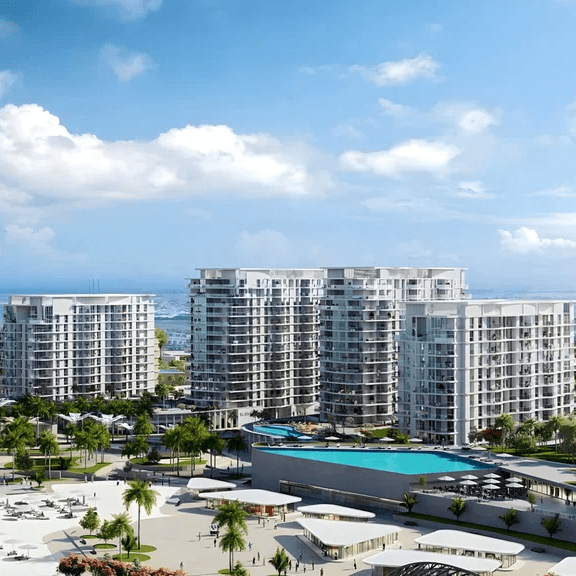Perhaps everybody has heard about Palm Jumeirah in Dubai. Palm Jumeirah is a massive artificial island located in Dubai. It stands as one of the city's iconic landmarks, alongside its towering skyscrapers. The ambitious aim of this project was to draw even more tourists and investors from around the globe, and it has certainly succeeded. Presently, a substantial number of affluent individuals call this island home, relishing in a wide array of premium amenities. Nevertheless, living on an island comes with its own distinct characteristics that prospective villa and apartment owners should take into consideration. Read on and you will find out all about Palm Jumeirah island in Dubai.
What is Palm Jumeirah?
Palm Jumeirah is one of the three artificial palm-shaped islands in Dubai. The concept, conceived in the early 2000s, aimed to expand Dubai's natural coastline, which was initially only 72 kilometers long. Palm Jumeirah, Palm Jebel Ali, and Palm Deira were intricately designed to resemble palm trees. The developers of Dubai palm islands anticipated covering the project's costs through the sale of land plots for hotels and private villas.
ORLA Residential Complex on Palm Jumeirah (Housearch)
The "palm project" proved to be extensive and challenging. Since the desert sand was inadequate for forming the island base, developers dredged soil from the bottom of the Persian Gulf. The construction required a specialized fortification system, a network of breakwaters, and water circulation facilities to prevent water inside the island from becoming stagnant. This substantial human intervention in the ecosystem raised concerns among environmentalists, who warned of potential harm to various species inhabiting the Persian Gulf. Geophysicists also cautioned that the gradual rise in sea levels could threaten the islands within 40-50 years. Nevertheless, the designers attempted to demonstrate that even considering the current rate of glacier melting, the archipelago could persist for several hundred years.
Ultimately, business interests prevailed over scientific concerns. Construction of the first island, Palm Jumeirah, commenced in 2001, generating significant excitement. Plots on the island were swiftly sold, and development began. However, the global financial crisis hit in 2008, causing construction companies to suffer substantial losses due to reduced demand and falling property prices in Dubai. Some individuals who had invested in plots on other islands found themselves in the unfortunate position of defrauded real estate investors, as many projects came to a halt. Over time, construction on the islands gradually resumed.
Palm Jumeirah, situated along the Persian Gulf coastline, takes the form of a palm tree and comprises a trunk, 16 fronds, and a crescent-shaped, 11-kilometer breakwater encircling the island. Access to the mainland is provided by a 300-meter bridge. Presently, the island is home to approximately 80,000 residents.
New buildings in the UAE
What You Need to Know if You Plan to Live on Palm Jumeirah
As the saying goes, a picture is worth a thousand words. Are you the one of those who want to buy a Palm Jumeirah island villa? For those considering settling down on Palm Jumeirah Island, it's highly advisable to visit and experience it firsthand. Life on the island offers both advantages and disadvantages.
Now, let's discuss the drawbacks. What problems can face Dubai Palm Jumeirah island residents? Many people may be less than thrilled with the high-density development on the island. In certain areas, houses are constructed practically wall to wall. Others might be disappointed to find that the water is not as clear and transparent as depicted in promotional materials. The presence of breakwaters has disrupted its natural circulation, leading to occasional silt buildup. Some residents may also be bothered by the ongoing construction noise in certain parts of the island.
The island's transportation options have room for improvement as well. Different parts of Palm Jumeirah are connected by a monorail. However, since it is operated by a private company, it doesn't offer the same fare benefits as public transport, and tickets tend to be more expensive. Additionally, there is no subway station on the island. To reach the Dubai mainland, you must first take a tram for about 30 minutes and then transfer to the subway. In terms of proximity to the airport, the island is relatively far by local standards, approximately an hour's drive away. On a positive note, traffic congestion on the island has improved in recent times, thanks to city authorities updating the network of traffic lights and road systems.
Now, let's explore the island's advantages. Palm Jumeirah is often referred to as the eighth wonder of the world, and this accolade is well-deserved. The way it was created is nothing short of miraculous, and its stunning appearance lives up to the hype. It's truly a paradise on earth. Here, you'll find some of the finest five-star hotels, including Atlantis The Palm, which has earned its seven-star reputation for its unparalleled luxury and top-notch service. Burj Al Arab, the iconic sail-shaped hotel, also graces the island with its presence. For shopping enthusiasts, there are two malls to choose from: Golden Mile Galleria and Nakheel Mall, the largest mall in Dubai. You'll also find Spinney's and Choithram supermarkets for your convenience on Palm Jumeirah. Don't miss the chance to admire the captivating Palm Fountain, currently the largest in Dubai. Other attractions include an observation deck on the 52nd floor of Pal Tower, Palm West Beach (one of the island's finest beaches where you can rent jet skis, catamarans, go kayaking, or try SUP), two water parks, and The Pointe promenade. The Pointe is often referred to as an open-air shopping and entertainment center, boasting around 80 restaurants, cafes, boutiques, and children's attractions. Furthermore, the island boasts numerous gyms, sports facilities, and outdoor running tracks scattered throughout. If you're in the mood for a leisurely stroll, there are several welcoming parks on the island as well.
Burj Al Arab. Photo: Sam valadi (Flickr)
Nevertheless, residents of the island should keep in mind that these attractions are not exclusively for their enjoyment. People from other parts of Dubai and tourists also flock to these attractions, so it can get quite crowded on weekends and during the cooler months of the year. Traveling by car can become a bit tedious during various events or concerts that draw large crowds of spectators.
Real Estate on the Island
What about Palm Jumeirah island villas in Dubai? Palm Jumeirah is not called the "Beverly Hills of the Middle East" for nothing. The majority of the island is adorned with opulent villas, each with its private access to the sea. These mansions are perched on the palm fronds, with a security post guarding each entrance. The ambiance here is one of solitude and tranquility, as all the shopping malls, hotels, stores, and health and entertainment complexes are situated far from this exclusive residential area. They are concentrated along the "trunk" of the palm.
Villas on the island come in various designs, sizes, and consequently, prices. For instance, the villas in Garden Homes, situated on several palm fronds, showcase Mediterranean, Arabic, Moroccan, and Greek architectural styles. Typically, a villa boasts four or five bedrooms, private beach access, and a swimming pool. How much does Palm Jumeirah island villa cost? As an example, you can acquire a 621 sq. m villa with four bedrooms, a fully furnished and equipped kitchen, along with appliances and a garage, for 19.8 million AED ($5.44 million).
The Palm Jumeirah is famous for its luxury villas. Nonetheless, the island isn't solely composed of private residences; there are also apartment complexes. Take Shoreline Apartments, for instance, which comprises 20 buildings situated on the eastern half of the "trunk," directly on the waterfront. Each cluster of buildings features a beach club equipped with a pool, gym, sports facilities, spa, as well as cafes, restaurants, and supermarkets.
Property prices on the island exhibit significant variation. For example, a studio typically ranges around 780,000 AED ($212,300), while a one-bedroom apartment is priced at about 970,000 AED ($264,000). A two-bedroom apartment commands a cost of approximately 1.45 million AED ($394,700), while a three-bedroom apartment averages around 1.9 million AED ($517,200). The average price for a four-bedroom apartment is 3.99 million AED ($1.08 million), while a five-bedroom apartment can cost up to 9.9 million AED ($2.7 million). In the villa category, a two-bedroom villa is typically priced at 2.6 million AED ($707,800), while one with seven bedrooms is valued at 21 million AED ($5.7 million). For a mansion with a higher number of bedrooms, the price can reach 55 million AED ($14.9 million).
AVA at Palm (Housearch)
Who Lives on the Island
So, who lives on the Palm Jumeirah in Dubai? Only extremely wealthy people can afford living on Palm Jumeirah. Absolutely everything is expensive here: services, goods, groceries, entertainment. Prices in supermarkets can be 25-50% higher than in other areas of Dubai. Among residents of the island there are highly paid specialists from various companies, wealthy families with children, single and ambitious young people, beach enthusiasts, foreigners and local millionaires, for whom real estate on the island is their second home.
Interestingly, families with children don't seem to be concerned about the absence of schools on the island. Are there any schools nearby Palm Jumeirah? Several well-known educational institutions are conveniently located nearby. For instance, in the Al Sufouh area, you can find one of the oldest international schools, Gems Wellington, offering a British curriculum. Additionally, there is an American school nearby that follows the curriculum of the United States.
One Crescent Residential Complex on Palm Jumeirah (Housearch)
Families on Palm Jumeirah island often opt to purchase their own villas, while those who enjoy entertainment and young professionals often choose apartment complexes where housing is more affordable. Despite the higher costs, many people still choose to rent apartments on the island. For instance, renting a studio apartment costs 70,000 AED ($19,000) per year, and a one-bedroom apartment goes for 90,000 AED ($24,500) annually. However, there are individuals from around the world who are willing to pay a premium for the experience of living on an island that is visible from space.
In a Nutshell
Living on Palm Jumeirah is both expensive and prestigious. While there are drawbacks related to transportation accessibility, these are offset by the tranquility, seclusion, luxurious accommodations for villa residents, stunning sea views, and ample shopping and entertainment options for apartment residents. The island is also a fantastic vacation destination with its top-tier hotels, pristine beaches, and a wide range of leisure activities. Investing in real estate on the island is often seen as highly profitable, as apartments and villas in Palm island are popular choices for vacation rentals.
Cover photo: Abid Bin Nazar (pexels)




